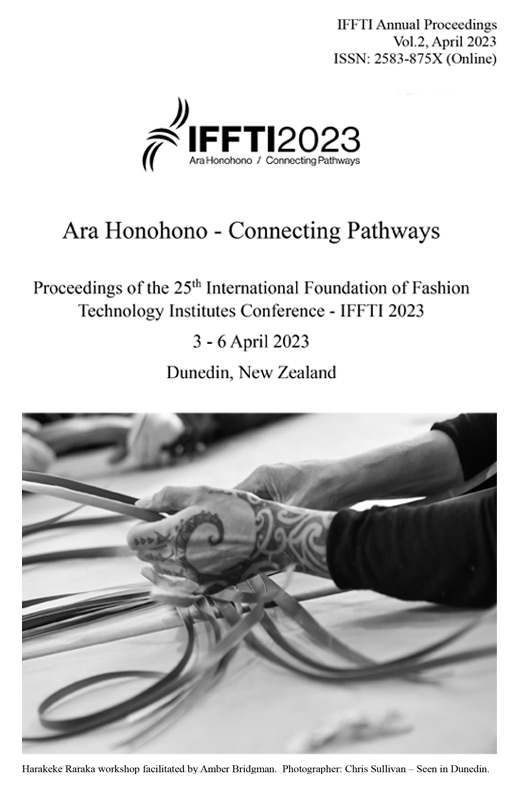IFFTI ANNUAL PROCEEDINGS 2023
INTRODUCTION
Locating the IFFTI conference for the first time in Aotearoa New Zealand was the impetus to create an experience that would be uniquely bi-cultural and based on the founding document of our nation, Te Tiriti o Waitangi, the Treaty of Waitangi. Working with mana whenua (the people of the land), we developed the kaupapa (theme) of Ara Honohono: Connecting Pathways.
Te Ara is a Māori word that means path or route but can also refer to a line of traditional Māori weaving. Honohono means to link, to join, to splice, to add and to join together.
Kaupapa also refers to the main body of a kākahu (traditional Māori cloak).
This kaupapa called us to reflect on connections, patterns, pathways and threads that bind us to our past and link us to our future, to culture, to people, to place, to practice.
We invited submissions based on three sub-themes:
Lines to the Past, Present, Future: He tāoka tuku iho: The treasures passed down to us from the ancestors, those tried and true wisdoms of old.
- What and who grounds us in our practice?
- How does the past inform the future in the context of the fashion industry?
- How can technology ensure that fashion remains relevant in the future?
Diversity of Voice: Kahikatea tū i te uru: Strength in numbers
- Fashion as voice and an agent – for indigenous peoples, for the under-represented, for change, for power and influence.
- How can we be open to different voices and learn from each other?
Accountability, Responsibility, Courage: He manawa tītī: A person with great endurance.
- What are our responsibilities as designers, makers, influencers, educators and consumers within the wider fashion eco-system?
- How do we advocate for a sustainable fashion future?
- Retaining a mix of workshops, posters, creative practice submissions, developmental papers and full papers, we received 182 submissions from Australia, Bangladesh, Canada, China, France, Hong Kong, India, Italy, Netherlands, New Zealand, Singapore, Spain, Sweden, Taiwan, USA, UK and Vietnam. Final selections resulted in 39 full papers, 11 developmental papers, 4 posters, 7 practice-based/exhibition and 3 workshops.
In a very fresh post-pandemic environment, conference organisers made the decision to offer a hybrid conference allowing for both in person and online presentation and participation. We want to acknowledge those who made the effort to travel to Aotearoa New Zealand at a time when airlines were still operating on reduced schedules. We also want to acknowledge the technical challenges associated with both in person and online delivery and thank participants for their patience. Overall, 66 delegates attended the conference in person with a further 44 online. All participants had access to presentations and recordings of sessions stored on the conference Teams site.
In addition to paper and poster presentations, exhibitions and workshops, conference organisers welcomed keynotes speakers and a panel over the two days. Opening conference keynote speaker, Megan Pōtiki, reflected on the influence of her tupuna (ancestors) on the European settlement of Ōtepoti Dunedin, our conference location. Megan has drawn on this cultural narrative to contribute to urban design projects and new buildings in the city.
Professor Margo Barton spoke with Jacinta Fitzgerald and Emily Miller-Sharma from Mindful Fashion NZ about the landscape of the New Zealand fashion industry, and the positive steps that Mindful Fashion New Zealand are taking to make the industry more sustainable.
Director of Sustainability at Otago Polytechnic, Ross McDonald, interviewed keynote Tara Viggo on her personal sustainability journey going from working as a pattern maker for high profile UK fashion houses to the creation of her own bespoke agency, Paper Theory patterns.
Tracy Kennedy chaired a panel of young Māori designers, all at different stages of their careers and encouraged them to reflect on the influence of whakapapa (lines of descent) and matauraka Māori (traditional Māori knowledge and wisdom) on their personal journey and practice as designers.
In person delegates were able to expand their understanding of fashion practice through stimulating exhibitions and workshop experiences and some chose to stay on after the conference to experience cultural activities, the beautiful natural environment and meet some of the wildlife!
Throughout the three days, in person delegates enjoyed the manakitaaka (hospitality) provided and judging from the lively buzz between sessions and at the conference dinner at Tītī Restaurant by the Pacific Ocean, made the most of the opportunities to network with like-minded academics and practitioners.
Ara Honohono: Connecting Pathways drew fashion researchers and practitioners together, to share their knowledge, highlighting the importance of place and identity in fashion practice. The conference provided a pathway to deepen whanaungatanga, a relationship through shared experiences and working together which provides people with a sense of belonging and connection.
Waiho i te toipoto, kaua i te toiroa – Let us keep close together, not far apart.
Professor Margo Barton and Caroline Terpstra
Conference convenors
Member's Area
Member's Directory
Membership Information
Application Form
events
job advertisement
image gallery

